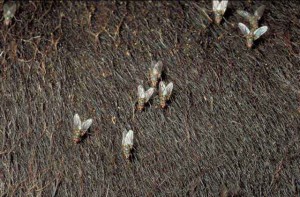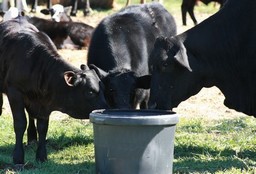Good nutrition management is a key to reproductive efficiency in heifers. Animal scientists at the university of Georgia Cooperative extension Service say heifers must be bred to calve at two years of age, and it is critical that they reach 65 percent of estimated mature weight prior to breeding.1 Nutrition management during this development period can have a great impact on lifetime productivity.
Because heifers require a higher quality diet, they must be fed separate from the mature cow herd. the Georgia animal scientists offer these additional thoughts about proper nutrition for heifer development:
Hay
Heifers are often developed using hay-based diets, but because grass hay will not provide enough energy for them to gain at optimal rates, their diets need to be supplemented with grains, by-product feeds, and/or high quality winter annual pasture. Feeding hay that is greater than 12 percent protein will require an energy supplement that is at least 9 percent or higher in crude protein. High quality hay fed with approximately 0.75 to 1 percent body weight of a dry grain supplement should provide acceptable gains. Because hay quality has such a dramatic impact on daily gains, it should be tested for nutrient content prior to feeding.
Winter annual Pastures
Winter annual pastures such as wheat, rye, oats, and ryegrass can provide sufficient nutrients for developing heifers with only a mineral supplement required. Begin supplementation as soon as grazing becomes limited. High levels of protein in winter annual forages can reduce reproductive efficiency. To counter this, cows can be limit-grazed for only a few hours each day; then supplemented with hay.
Corn silage
Corn silage may need a protein supplement to provide adequate gains for heifers. Commonly used feeds to supply additional protein are soybean meal, cottonseed meal, commercial supplements or a high protein by-product feed.
Limit Fed grain/by-Products
Typical grain-based diets can be limit-fed to develop replacement heifers, but be cautious because heifers will gain too rapidly if allowed free-choice access to a grain-based diet without ingredients to control intake. Limit-fed diets generally consist of 80 percent concentrate, including grain, by-product feeds, and protein supplements. The remainder consists of a roughage source and a mineral supplement.
Accuration Cattle Limiters, with intake modifying technology to control intake, are an excellent choice to develop heifers, and to get first-calf heifers re-bred.
IonoPHores
Ionophores have been shown to reduce age at puberty in replacement heifers by 14 to 28 days. Heifers that reach puberty earlier are more likely to breed early in the breeding season and continue producing a calf every 12 months.
In most herds, first-calf heifers are the most difficult group to get re-bred. Supplementing to improve body condition scores (BCS) for acceptable pregnancy rates may be necessary. First-calf heifers with a BCS of four at breeding will have pregnancy rates of approximately 50 percent, while those with a BCS of six will have about a 90 percent pregnancy rate.
Even in well-developed heifers, body weight and condition can be rapidly lost after calving. To maintain a high re-breeding rate, you can supplement existing forages or hay, graze winter annual pasture, or early wean the calf.
The total best nutritional solution for your replacement heifers is the culmination of more than 80 years of Purina research. Purina has developed two product lines to specifically meet the needs of your heifers. You can select from either Controlled Intake Systems with IM Intake Modifyingtechnology® or hand-fed 4-Square® Stocker/Grower Chow products.
Call our store to discuss how we can help you develop the proper nutrition program for your situation and production goals.
Source: Purina Cattle


